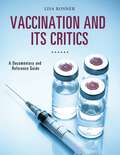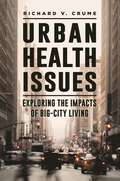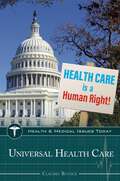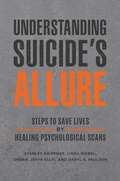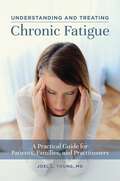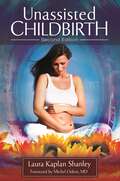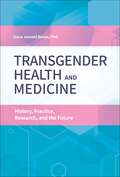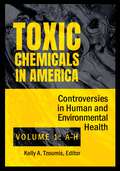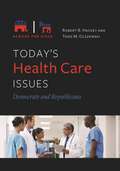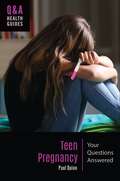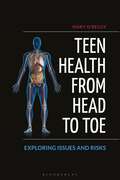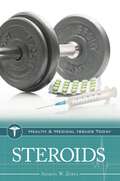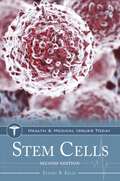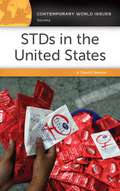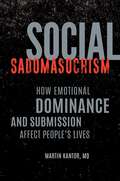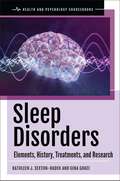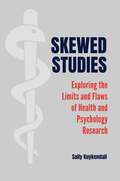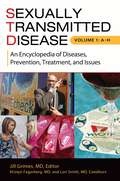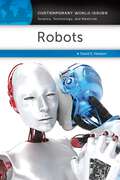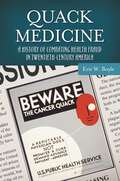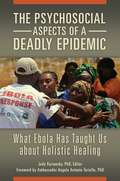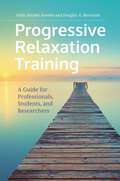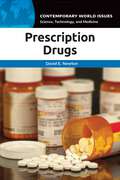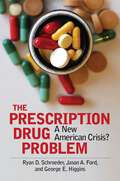- Table View
- List View
Vaccination and Its Critics: A Documentary and Reference Guide (Documentary and Reference Guides)
by Lisa RosnerThis authoritative and unbiased narrative—supported by 50 primary source documents—follows the history of vaccination, highlighting essential medical achievements and ongoing controversies.This timely work provides a comprehensive overview of the scientific breakthrough known as vaccination and the controversy surrounding its opposition. A timeline of discoveries trace the medical and societal progression of vaccines from the early development of this medical preventive to the eradication of epidemics and the present-day discussion about its role in autism. The content presents compelling parallels across different time periods to reflect the ongoing concerns that have persisted throughout history regarding vaccination.Author Lisa Rosner provides a sweeping overview of the topic, covering the development of modern vaccines and practices, laws governing the distribution of vaccines, patients' rights, consumer advocacy, and vaccination disasters. Throughout the volume, primary source documents present the perspectives of researchers, public health specialists, physicians, patients, consumer advocates, and government officials, helping to illuminate the past, present, and future of vaccines on a global level.
Urban Health Issues: Exploring the Impacts of Big-City Living
by Richard V. CrumeLiving in an urban environment can have a major influence—both positive and negative—on one's physical health and mental well-being. This book examines more than 20 key issues related to city living and what's being done to address them.According to recent statistics, 80.7 percent of Americans live in urban areas, and more than half of the world's population lives in cities. From various types of pollution to crime to overcrowding, the urban environment can have massive impacts on our physical, psychological, and social health and well-being. Moreover, while certain aspects of living in a city, such as access to health care, can improve the lives of many, other factors can have detrimental effects and can lead to inequalities along racial and socioeconomic lines.Urban Health Issues: Exploring the Impacts of Big-City Living examines 23 key issues related to urban health, exploring their causes and consequences in depth and highlighting what cities and individuals can do to safeguard the well-being of urban residents. It also draws comparisons between cities in the United States and the industrialized world and those in poor and developing nations, providing important global insights. The material is brought to life by fascinating city case studies and illuminating interviews with experts working in a variety of fields.
Universal Health Care (Health and Medical Issues Today)
by Claudio ButticèThis accessibly written book explains universal healthcare; the many forms it can take; and the issues, debates, and historical context underpinning the continued struggle for its implementation in the United States.Universal healthcare may be defined as any healthcare system that ensures at least basic coverage to most, if not all, citizens of a country. Although it may be implemented in many ways, universal healthcare has been widely accepted by international humanitarian organizations such as the World Health Organization (WHO) as the best way to ensure the universal human right to health. So why is the United States the only industrialized country without universal healthcare? What are the political, social, and economic factors that have prevented its successful introduction?Universal Healthcare explores what universal healthcare is, the many forms it can take—using examples from countries around the world—and the tumultuous history of attempts to implement a system of universal healthcare in the United States. Part II delves into the contentious issues and debates surrounding adoption of universal healthcare in the United States. Lastly, Part III provides a variety of useful materials, including case studies, a timeline of critical events, a glossary, and a directory of resources.
Understanding Suicide's Allure: Steps to Save Lives by Healing Psychological Scars
by Stanley Krippner Linda Riebel Debbie Joffe Ellis Daryl S. PaulsonThis book explains why suicide can be alluring to a person aiming to stop his or her traumatic pain—whether its source is bullying, sexual assault, war combat, or other PTSD-invoking events—and details approaches that can prevent suicide.Suicide has been a taboo topic in Western culture. The mere mention of suicide sparks reactive responses that include medical, moral, spiritual, and religious debates. As a result, the authors open an important discussion here, offering an honest and non-judgmental examination of the many aspects involved in the nature of suicide, explaining that above all, people need to learn how to support those struggling with suicidal thoughts or to intercept their own suicidal thinking. The book also includes an extensive review and evaluation of the many available mental health treatments.Special consideration is given to military suicides. U.S. soldier suicides exceed one per day and continue to rise in all military branches, while veteran suicide rates are even higher, averaging 17 per day. Communities, families, veterans, and service members are in need of tools and insights for coping with, navigating, and exposing the suicidal attitudes affecting many current and former members of the military.
Understanding and Treating Chronic Fatigue: A Practical Guide for Patients, Families, and Practitioners
by Joel L. YoungSome doctors still think Chronic Fatigue Syndrome is a "fake" diagnosis. In this book, Joel Young, MD, presents the research, experience, and treatments that prove otherwise.Millions of Americans experience chronic fatigue syndrome (CFS), a continuous exhaustion and a feeling comparable to that of having just run a marathon when all they have done is a daily living task, such as taking a shower or getting dressed.Doctors don't have tests for CFS, and some think it's a faux or psychological disorder. Joel Young, MD, in this heavily researched book, explains why it is a true physical illness and how it may be treated. He details how he successfully treats the symptoms, which can include severe fatigue, "brain fog," chronic pain, and sleep problems. Unlike doctors who recommend exercise, supplements, or opioid medications, Young integrates such options as long-acting stimulants, meditation, and dietary changes to reduce fatigue, as well as non-opioid drugs, medical marijuana, and self-help options including yoga for the associated chronic pain.
Unassisted Childbirth
by Laura Kaplan ShanleyThis book reveals how giving birth is an inherently safe, relatively painless process that is best performed without the assistance of doctors or midwives, and how confidence and a positive attitude reduces fear—and therefore the pain—of labor.According to Laura Kaplan Shanley, a renowned leader in the natural-birth movement, human birth is inherently safe and relatively painless—provided we refrain from physical or psychological interference. The problems often associated with birth can be traced to three main factors: poverty, unnecessary medical intervention, and fear. When these causes are eliminated, most women can give birth either alone or with the help of a partner, friends, or family.This second edition of Unassisted Childbirth leads with a history of childbirth and then describes how most deliveries occur today, detailing why these processes don't serve mothers or babies. The information in this unique book gives women yet another legitimate choice in childbirth that doesn't rely on doctors and technology, and allows parents, birth professionals, and general readers to reexamine their most basic ideas about birth and learn to think in new ways.
Transgender Health and Medicine: History, Practice, Research, and the Future (Essentials of Psychology and Health)
by Dana Jennett Ph.D.This text starts with the history of transgender science and provides current, evidence-based information on theories and treatment procedures, concluding with projections of future scientific developments.A transgender person is one whose congruent gender behavior (e.g., masculine, feminine, genderqueer) does not match the culturally assigned gender category based on their sex at birth. For example, a transgender person may behave and present as a woman despite being born with male genitalia.This book provides background on transgender history, needs, assessment, and procedures; side effects of procedures; and outcomes that all providers need to understand to treat transgender patients and relate to their particular expectations.The current etiquette basis for establishing an effective provider-patient relationship is highlighted. Pathological terms are no longer acceptable and new non-pathological terms are rapidly replacing them, because being transgender is now recognized as a natural part of diversity rather than a disease or disorder. Also included here are new theories of causation and treatment approaches for providers.The book additionally outlines current and earlier schools of thought and provides an integrated theory of transgender causation that includes genetic, epigenetic, cultural, and early learning/emergence factors and highlights research needs and expected future research topics.
Toxic Chemicals in America [2 volumes]: Controversies in Human and Environmental Health [2 volumes]
by Kelly A. TzoumisThis one-stop resource is ideal for understanding the extent to which toxic chemicals are used in U.S. industry and agriculture—impacting public health and the environment through everything from industrial solvents to children's toys.Every year, about 4 billion pounds of toxic chemicals are generated and released by U.S. industries. Do these chemicals pose a potential health threat to American families, including vulnerable groups like children and the elderly? Is their manufacture and use adequately regulated to protect both human and environmental health? Is the Chemical Safety for the 21st Century Act, signed in June 2016 by President Barack Obama with bipartisan support, truly the first major overhaul of toxic chemical regulation in 40 years to put human health first, as its supporters asserted? Or is it a fatally flawed bill that does the bidding of industry by undermining strong state environmental and public health laws, as some detractors claim?This two-volume set addresses all of those questions. Moreover, it presents and examines arguments marshaled by business interests, community leaders, scientists, activists, and lawmakers alike. It thus provides users with the information they need to accurately assess the impacts—pro and con—that industrial chemicals are having in shaping the world in which we work, eat, drink, breathe, and play.
Today's Health Care Issues: Democrats and Republicans (Across the Aisle)
by Robert B. Hackey Todd M. OlszewskiThis book provides a comprehensive introduction to significant U.S. health policy controversies, including Democratic and Republican responses to the coronavirus pandemic. It explores partisan divisions, major challenges, and policy preferences of key Democratic and Republican stakeholders.This volume provides readers with a broad overview of a variety of issues in contemporary health policy that span health care reform, health insurance, pharmaceuticals, public health, health care for underserved populations, and responses to the COVID-19 pandemic. The book explores the politics of each issue, drawing upon historical evidence, legislative research, public opinion polls, and the views of key decision makers from both Democratic and Republican perspectives. This coverage provides readers with a clear sense of how policymakers from each party think about the issues involved.This resource devotes special attention to the COVID-19 public health crisis, providing authoritative coverage of the actions, rhetoric, and policy choices of President Trump and his administration, governors across the nation, and leaders of Congress from both parties. This chapter, like all others in the book, is written so that it is accessible to readers from a variety of audience levels, including students and general readers.
Teen Pregnancy: Your Questions Answered (Q&A Health Guides)
by Paul QuinnPregnant teens have three options—abortion, adoption, and keeping the baby—and each comes with its own challenges and issues.Teen pregnancy can have an enormous impact on adolescents, their families, and society. What options are available to teens? What resources are available, and what rights and responsibilities do the pregnant teen, the father, and the teen's parents have? Do pregnancy and birth pose unique health risks for mother and child? How does being born to a teen mother affect a child&’s health and future?Part of Greenwood&’s Q&A Health Guides series, Teen Pregnancy: Your Questions Answered follows a reader-friendly question-and-answer format that anticipates readerS&Rsquo; needs and concerns. Prevalent myths and misconceptions are identified and dispelled, and a collection of case studies illustrates key concepts and issues through relatable stories and insightful recommendations. Each book in the series also includes a section on health literacy, equipping teens and young adults with practical tools and strategies for finding, evaluating, and using credible sources of health information both on and off the internet—important skills that contribute to a lifetime of healthy decision-making.
Teen Health from Head to Toe: Exploring Issues and Risks
by Mary O'ReillyThis book offers a head-to-toe look at the health concerns most pertinent to teens and young adults as well as what they can do to safeguard their health. It also provides general information on anatomy and function.Many of the United States' top health problems—including heart attack, stroke, and complications from type 2 diabetes—are relatively uncommon among teens and young adults. There are, however, a number of health risks that are of particular concern for individuals between the ages of 13 and 25. Many of the behaviors this age group is likely to participate in—from listening to loud music to vaping to constantly using smartphones—can have a profound impact on their health.This book examines these threats to teen health using a top-to-bottom organization that focuses on particular parts of the body and systems. Each chapter provides background information on the anatomy and function of each part or system before diving into the issues most pertinent to teens. Readers will discover how these threats arise, how they can affect health both now and in the future, and what can be done to prevent, treat, or minimize the impact of these threats. Each chapter also includes a selection of accessible further readings that can be used as a jumping-off point for additional research.
Steroids (Health and Medical Issues Today)
by Aharon W. ZoreaA thorough, balanced examination of the controversies on the therapeutic and non-therapeutic use of steroids that covers both legal medical therapy and illegal performance enhancement.The discussions regarding the ethical, medical, and social controversies surrounding steroid use are as heated as the drugs themselves are powerful. Steroids comprehensively addresses the separate debates over steroid use in therapeutic medical treatments, sports performance enhancement, and cosmetic lifestyle choices. The contents provide balanced coverage of the complex positive and negative implications involved with using these "ingredients of youth" to evade the common ailments of old age and to overcome some of the limitations of natural biology. This book will be invaluable to students of not only health and exercise sciences, sports and sport-related fields, and medical science, but also those researching social and ethical questions involved with the use of steroids in related fields. For example, the book may be used by sociology students investigating social aspects of sports, health policy, and public role models; psychology students focusing on the role of self-image and mental health; and political science students researching public health policy.
Stem Cells (Health and Medical Issues Today)
by Evelyn B. KellyThis accessibly written book explores the different types of stem cells, their current and potential future medical applications, and the many controversies that surround their creation and use.Whether from adults or embryos, stem cells have the potential to develop into many other types of cells—an ability that makes them potentially invaluable for curing a wide variety of diseases and disorders. And while some stem cell treatments are already in use today and have achieved remarkable results, the use of such cells continues to be clouded in controversy.This second edition of Steam Cells offers a wealth of new information and features. Coverage of research breakthroughs in the past decade has been added, including descriptions of recently discovered types of stem cells and stem cell therapies. In addition to addressing ethical and scientific controversies, the book also addresses issues such as the discrepancy between the public's expectations for regenerative medicine and current medical realities. Also new in this edition is a collection of case studies, each of which helps to make the topics discussed in the book more accessible to readers.
STDs in the United States: A Reference Handbook (Contemporary World Issues)
by David E. NewtonSTDs in the United States: A Reference Handbook provides information about sexually transmitted diseases and infections and their impact on both an individual and a societal level.STDs in the United States: A Reference Handbook provides extensive background on the diagnosis, treatment, consequences, and public understanding of STDs. It also makes available to readers a host of tools and resources with which they can expand that understanding by carrying out additional research on the topic. While this book provides much of the information about STDs found in other books for young adults, it does so in greater detail, which will help readers to make informed choices related to their sexual health. An array of resource materials includes information about important individuals and organizations in the field of STDs, a collection of data and relevant documents about STDs, an extensive annotated bibliography, a chronology, and a glossary. The first two chapters deal with the history and spread of STDs, along with detailed analysis of current related problems and possible solutions. An additional chapter includes essays by individuals writing on specific topics in the field.
Sports Injuries: Your Questions Answered (Q&A Health Guides)
by James H. JohnsonThis book explores how to recognize, treat, and prevent sports injuries and offers guidance on which sports and training techniques are most likely to lead to injury.Engaging in sports has numerous health benefits, but it's an unfortunate reality that it can also lead to injury. Some sports, such as football and cheerleading, are particularly notorious for causing harm to young athletes. Specializing in a particular sport or going too hard too fast can also lead to injury. But which injuries are most likely to occur, and how should they be treated in both the short- and long-term? When should an injured athelete consider surgery? When is it safe to get back in the game?Books in Greenwood's Q&A Health Guides series follow a reader-friendly question-and-answer format that anticipates readers' needs and concerns. Prevalent myths and misconceptions are identified and dispelled, and a collection of case studies illustrate key concepts and issues through relatable stories and insightful recommendations. Each book also includes a section on health literacy, equipping teens and young adults with practical tools and strategies for finding, evaluating, and using credible sources of health information both on and off the internet—important skills that contribute to a lifetime of healthy decision-making.
Social Sadomasochism: How Emotional Dominance and Submission Affect People's Lives
by Martin Kantor MDExplains the subtle but pervasive aspects of sadomasochism that affect everyday relationships across our lives, detailing when the power and control dynamics become neurotic and describing actions that can be taken to better individuals and improve society.For most people, a whip-wielding, leather-clad sexual subculture comes to mind when they hear the phrase "sadomasochism." But as psychiatrist Martin Kantor explains in this book, sadomasochism is generally about power, control, dominance, and submission, dynamics that are subtle and pervasive in all of our lives, from home life to work life to social interactions including political arenas. The bottom line: sadomasochism is about the giving or receiving pleasure from the infliction or reception of pain or humiliation and both pain and pleasure can be purely emotional, no sexual or physical context necessary. Kantor deconstructs sadomasochism to show us how it affects each of us, consciously or not. He explains the "life phases" of sadomasochism, the role early trauma plays in this self-defeating action when it reaches a neurotic level, and the damage it does to individuals, loved ones, and society. This ground-breaking book will appeal to psychology students and researchers, as well as general readers with an interest in psychology.
Sleep Disorders: Elements, History, Treatments, and Research (Health and Psychology Sourcebooks)
by Kathleen J. Ph.D. Gina GraciThis sourcebook presents the history of sleep disorders, from restless legs to insomnia to night terrors, alongside emerging research, illustrations of sleep disorders in society, and treatments.Part of the Health and Psychology Sourcebooks series, this compact volume offers concise information on an issue threatening human health and well-being: sleep disorders. The authors are established psychologists and researchers specializing in the study of sleep and sleep disorders, one an editor for the Journal of Sleep Disorders and Therapy and the other a certified behavioral sleep medicine specialist.The book begins with an introduction that underscores how prevalent sleep disorders and the condition of sleep deprivation are in this nation and why they are considered a public health concern. Chapters explain and illustrate disorders including apnea, insomnia, narcolepsy, nightmares, night terrors, and sleepwalking, with each chapter providing an empirical review followed by a case study. For each disorder, history; signs and symptoms; incidence; theory; personal, familial, societal, and economic factors; treatments and solutions; and emerging research are included.
Skewed Studies: Exploring the Limits and Flaws of Health and Psychology Research
by Sally KuykendallIn these uncertain times, how much can you trust health news? Is the research behind breaking headlines reliable? This book is an indispensable resource for students and general readers, helping them evaluate and think critically about health information."People Who Drink Coffee Live Longer." "Students Learn Better When Listening to Classical Music." "Scientists Discover the Gene That Causes Obesity." We are constantly bombarded with reports of "groundbreaking" health findings that use attention-grabbing headlines and seem to be backed by credible science. Yet many of these studies and the news articles that discuss them fall prey to a variety of problems that can produce misleading and inaccurate results. Some of these may be easy to notice—like a research study on the benefits of red meat funded by the beef industry, or a study with a sample size of only 10 people—but others are much harder to spot.Skewed Studies: Exploring the Limits and Flaws of Health and Psychology Research examines the most pervasive problems plaguing health research and reporting today, using clear, accessible language and employing real-world examples to illustrate key concepts. Beyond simply outlining issues, it provides readers with the knowledge and skills to evaluate research studies and news reports for themselves, improving their health literacy and critical thinking skills.
Sexually Transmitted Disease [2 volumes]: An Encyclopedia of Diseases, Prevention, Treatment, and Issues [2 volumes]
by Jill Grimes, MD, FAAFPThis up-to-date, two-volume work provides A-Z coverage of all topics related to sexually transmitted disease, ranging from anatomy to modern legal and social implications to past and present methods of prevention, diagnosis, and treatment.Sexually transmittable diseases are a sensitive and embarrassing subject. Many sexually transmitted diseases are silent, providing no symptoms until they cause serious medical problems. But with one in four Americans over the age of fourteen being infected with a sexually transmitted infection, the topic of sexually transmitted diseases (STDs) is a highly relevant health issue. This work contains over 230 entries that span the history and wide range of topics regarding STDs, from the birth of condoms over 3,000 years ago through discovery of the infectious agents and the invention of effective vaccines to the legal and societal implications of STDs.This two-volume encyclopedia investigates the spectrum of sexually transmitted diseases and related topics and issues, describing their microscopic origins, the chronology of research and medical treatment, the body parts affected, and the modern-day methods of diagnosis, treatment, and prevention of spread. Additionally, this work addresses legal implications of disease transmission, psychosocial impacts, as well as long-term medical consequences such as potential infertility, pelvic inflammatory disease, and chronic pelvic pain.
Robots: A Reference Handbook (Contemporary World Issues)
by David E. NewtonRobots: A Reference Handbook differs from most other books on robotics in the variety of resources that it provides to readers of all ages.Robots: A Reference Handbook teaches readers about a wide variety of robots. It opens with a history of robotics, dating to ancient Greece and Rome, at which time an impressive array of automata were invented for entertainment, religious, and instructional purposes. It follows the development of automata and robots in ancient China and the Islamic world, through to Western Civilization in the present day. Subsequent chapters describe the wide array of applications to which robots are put today and discuss the technical, social, political, ethical, and economic issues created by their increasing use. Additionally, a number of essays by interested individuals highlight various aspects of robotics development. The remaining chapters of the book provide resources that will assist readers in learning more about the topic of robotics.
Quack Medicine: A History of Combating Health Fraud in Twentieth-Century America (Healing Society: Disease, Medicine, and History)
by Eric W. BoyleThis timely volume illustrates how and why the fight against quackery in modern America has largely failed, laying the blame on an unlikely confluence of scientific advances, regulatory reforms, changes in the medical profession, and the politics of consumption.Throughout the 20th century, anti-quackery crusaders investigated, exposed, and attempted to regulate allegedly fraudulent therapeutic approaches to health and healing under the banner of consumer protection and a commitment to medical science. Quack Medicine: A History of Combating Health Fraud in Twentieth-Century America reveals how efforts to establish an exact border between quackery and legitimate therapeutic practices and medications have largely failed, and details the reasons for this failure.Digging beneath the surface, the book uncovers the history of allegedly fraudulent therapies including pain medications, obesity and asthma cures, gastrointestinal remedies, virility treatments, and panaceas for diseases such as arthritis, asthma, diabetes, and HIV/AIDS. It shows how efforts to combat alleged medical quackery have been connected to broader debates among medical professionals, scientists, legislators, businesses, and consumers, and it exposes the competing professional, economic, and political priorities that have encouraged the drawing of arbitrary, vaguely defined boundaries between good medicine and "quack medicine."
The Psychosocial Aspects of a Deadly Epidemic: What Ebola Has Taught Us about Holistic Healing (Practical and Applied Psychology)
by Judy KurianskyEdited by a clinical psychologist who has been on the ground helping to develop psychosocial support for Ebola survivors in one of the hardest-hit regions of West Africa, this book explains the devastating emotional aspects of the epidemic and its impact on survivors and the population in West Africa, families in the diaspora, and people in the United States and other countries. It also describes lessons learned from past epidemics like HIV/AIDS and SARS, and valuable approaches to healing from future epidemics.While the devastating Ebola epidemic has been contained, the effects of this outbreak—referred to by the World Health Organization as "the most severe acute public health emergency seen in modern times"—have wreaked a tremendous emotional toll on the populations of West Africa as well as on families and survivors worldwide. This groundbreaking book covers the psychosocial needs, programs, and policies related to the Ebola epidemic and examines broader lessons of the outbreak, such as changes in the ways in which healing from future epidemics can be handled.Edited by Judy Kuriansky, PhD, a noted clinical psychologist and United Nations NGO representative with extensive experience helping after disasters worldwide, and direct experience gained from being "on the ground" in West Africa in the midst of the epidemic, this book identifies and explains universal psychological factors at play in all such crises. It debunks myths regarding Ebola and describes the resulting psychological and social harm caused by the epidemic. The chapters cover overarching emotional issues and problems as well as the long-term impact on at-risk groups, such as children, women, and health workers; the impact of emotional issues on social and economic life; responses of government officials, media, and various aid organizations; and solutions being offered by groups worldwide, including service and humanitarian organizations, politicians, policymakers, and public health education groups.
Progressive Relaxation Training: A Guide for Professionals, Students, and Researchers
by Holly Hazlett-Stevens Douglas A. BernsteinOffers comprehensive guidance for practitioners, students, and researchers in psychology, psychiatry, and counseling to teach relaxation to clients.Two clinical psychologists widely known for their writings on relaxation present state-of-the-art methods for teaching clients to ease muscle and mind tension to deal with stress and anxiety disorders, as well as other conditions where stress and anxiety play a role. Bernstein and Hazlett-Stevens explain who the targets for Progressive Relaxation Training (PRT) are; the rationale, basic procedures, and variations of PRT; the setting and possible problems and solutions of PRT; and how to assess a client's progress. They also address hypnosis, drugs, and PRT, as well as PRT used in a mindfulness-based clinical practice. Case studies and evaluative research in PRT are also included. Students and practitioners in psychology, psychiatry, and counseling will find this work of interest. This book may also be useful supplemental reading for behavior modification courses and practicum courses in behavior therapy.
Prescription Drugs: A Reference Handbook (Contemporary World Issues)
by David E. NewtonPrescription drugs are a basic and invaluable part of society today, but there is debate surrounding the methods of testing new drugs, the possible misuse of prescription drugs, and the economics of drug production and use.This book examines the evolution of prescription drugs in the United States, as well as the formation of the pharmaceutical industry. It begins with a history of prescription drugs, dating back to their origins, then moves through the Industrial Revolution and into the present day. It also delves into the issues and controversies related to prescription drugs, such as drug costs, regulations, prescription drug abuse, insurance complications, and more. Both implemented and proposed solutions are also discussed. One of the most valuable aspects of the book is that it surveys the history of prescription drugs in a manner that helps the reader identify key issues in an easy-to-understand fashion. Finally, the perspectives chapter allows a broad range of voices to be heard, allowing crucial, diverse perspectives to round out the author's expertise.
The Prescription Drug Problem: A New American Crisis?
by Ryan D. Schroeder Jason A. Ford George E. HigginsProviding an indispensable resource for undergraduate students, graduate students, and policymakers interested in the prescription drug abuse crisis in the United States, this book summarizes the current state of prescription drug abuse and its growth over the past 20 years.The Prescription Drug Problem analyzes the growth of the prescription drug abuse problem from 1994 to 2014 and includes comparisons to marijuana and hard drug use during the same period. Specific attention is given to prescription opiate abuse and the transition from prescription opiates to heroin. The book begins with a broad overview of the prescription drug problem in the U.S., while the text presents stories of celebrities who have struggled with prescription drug abuse, highlights a handful of ordinary Americans who are battling prescription drug abuse, and examines as case studies a few communities that have been ravaged by prescription drug abuse. Drawing upon demographic patterns of abuse to identify causes of and factors contributing to prescription drug abuse as well as possible solutions to the problem, the book is designed to provide a broad overview of the prescription drug abuse problem in the U.S. and stimulate additional research.
